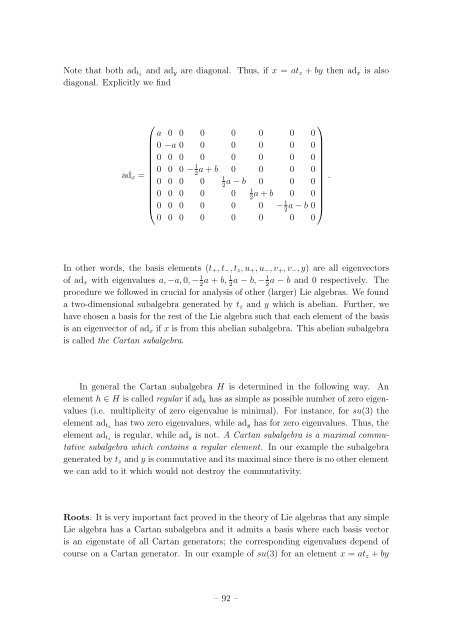Student Seminar: Classical and Quantum Integrable Systems
Student Seminar: Classical and Quantum Integrable Systems
Student Seminar: Classical and Quantum Integrable Systems
You also want an ePaper? Increase the reach of your titles
YUMPU automatically turns print PDFs into web optimized ePapers that Google loves.
Note that both ad tz <strong>and</strong> ad y are diagonal. Thus, if x = at z + by then ad x is also<br />
diagonal. Explicitly we find<br />
⎛<br />
⎞<br />
a 0 0 0 0 0 0 0<br />
0 −a 0 0 0 0 0 0<br />
0 0 0 0 0 0 0 0<br />
ad x =<br />
0 0 0 − 1 2 a + b 0 0 0 0<br />
1<br />
0 0 0 0<br />
2 a − b 0 0 0<br />
.<br />
1<br />
0 0 0 0 0<br />
2<br />
⎜<br />
a + b 0 0<br />
⎝ 0 0 0 0 0 0 − 1a − b 0 ⎟<br />
2<br />
⎠<br />
0 0 0 0 0 0 0 0<br />
In other words, the basis elements (t + , t − , t z , u + , u − , v + , v − , y) are all eigenvectors<br />
of ad x with eigenvalues a, −a, 0, − 1a + b, 1a − b, − 1 a − b <strong>and</strong> 0 respectively. The<br />
2 2 2<br />
procedure we followed in crucial for analysis of other (larger) Lie algebras. We found<br />
a two-dimensional subalgebra generated by t z <strong>and</strong> y which is abelian. Further, we<br />
have chosen a basis for the rest of the Lie algebra such that each element of the basis<br />
is an eigenvector of ad x if x is from this abelian subalgebra. This abelian subalgebra<br />
is called the Cartan subalgebra.<br />
In general the Cartan subalgebra H is determined in the following way. An<br />
element h ∈ H is called regular if ad h has as simple as possible number of zero eigenvalues<br />
(i.e. multiplicity of zero eigenvalue is minimal). For instance, for su(3) the<br />
element ad tz has two zero eigenvalues, while ad y has for zero eigenvalues. Thus, the<br />
element ad tz is regular, while ad y is not. A Cartan subalgebra is a maximal commutative<br />
subalgebra which contains a regular element. In our example the subalgebra<br />
generated by t z <strong>and</strong> y is commutative <strong>and</strong> its maximal since there is no other element<br />
we can add to it which would not destroy the commutativity.<br />
Roots. It is very important fact proved in the theory of Lie algebras that any simple<br />
Lie algebra has a Cartan subalgebra <strong>and</strong> it admits a basis where each basis vector<br />
is an eigenstate of all Cartan generators; the corresponding eigenvalues depend of<br />
course on a Cartan generator. In our example of su(3) for an element x = at z + by<br />
– 92 –

















